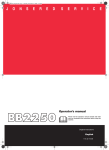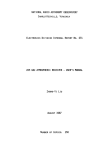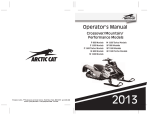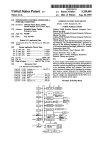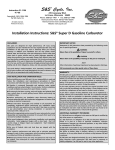Download - S&S Cycle
Transcript
Instruction 51-1271 1-23-07 S&S Cycle, Inc Copyright © 2007 235 Causeway Blvd. La Crosse, Wisconsin 54603 by S&S® Cycle, Inc. ® . Phone: 608-627-1497 • Fax: 608-627-1488 Technical Service Phone: 608-627-TECH (8324) Technical Service Email: [email protected] Website: www.sscycle.com All rights reserved. Printed in the U.S.A. Because every industry has a leader Emission-Related Installation Instructions for S&S® 49-State EPA Certified Engines DISCLAIMER: S&S parts are designed for high performance, off road, racing applications and are intended for the very experienced rider only. The installation of S&S parts may void or adversely effect your factory warranty. In addition such installation and use may violate certain federal, state, and local laws, rules and ordinances as well as other laws when used on motor vehicles used on public highways, especially in states where pollution laws may apply. Always check federal, state, and local laws before modifying your motorcycle. It is the sole and exclusive responsibility of the user to determine the suitability of the product for his or her use, and the user shall assume all legal, personal injury risk and liability and all other obligations, duties, and risks associated therewith. The words Harley®, Harley-Davidson®, H-D®, Sportster®, Evolution®, and all H-D part numbers and model designations are used in reference only. S&S Cycle is not associated with Harley-Davidson, Inc. SAFE INSTALLATION AND OPERATION RULES: Before installing your new S&S part it is your responsibility to read and follow the installation and maintenance procedures in these instructions and follow the basic rules below for your personal safety. Gasoline is extremely flammable and explosive under certain conditions and toxic when breathed. Do not smoke. Perform installation in a well ventilated area away from open flames or sparks. If motorcycle has been running, wait until engine and exhaust pipes have cooled down to avoid getting burned before performing any installation steps. Before performing any installation steps disconnect battery to eliminate potential sparks and inadvertent engagement of starter while working on electrical components. Read instructions thoroughly and carefully so all procedures are completely understood before performing any installation steps. Contact S&S with any questions you may have if any steps are unclear or any abnormalities occur during installation or operation of motorcycle with a S&S part on it. Consult an appropriate service manual for your motorcycle for correct disassembly and reassembly procedures for any parts that need to be removed to facilitate installation. Use good judgement when performing installation and operating motorcycle. Good judgement begins with a clear head. Don’t let alcohol, drugs or fatigue impair your judgement. Start installation when you are fresh. Be sure all federal, state and local laws are obeyed with the installation. For optimum performance and safety and to minimize potential damage to carb or other components, use all mounting hardware that is provided and follow all installation instructions. Motorcycle exhaust fumes are toxic and poisonous and must not be breathed. Run motorcycle in a well ventilated area where fumes can dissipate. • • • • • • • • • IMPORTANT NOTICE: Statements in this instruction sheet preceded by the following words are of special significance. WARNING Means there is the possibility of injury to yourself or others. CAUTION Means there is the possibility of damage to the part or motorcycle. NOTE Other information of particular importance has been placed in italic type. S&S recommends you take special notice of these items. WARRANTY: All S&S parts are guaranteed to the original purchaser to be free of manufacturing defects in materials and workmanship for a period of twelve (12) months from the date of purchase. Merchandise that fails to conform to these conditions will be repaired or replaced at S&S’s option if the parts are returned to us by the purchaser within the 12 month warranty period or within 10 days thereafter. In the event warranty service is required, the original purchaser must call or write S&S immediately with the problem. Some problems can be rectified by a telephone call and need no further course of action. A part that is suspect of being defective must not be replaced by a Dealer without prior authorization from S&S. If it is deemed necessary for S&S to make an evaluation to determine whether the part was defective, a return authorization number must be obtained from S&S. The parts must be packaged properly so as to not cause further damage and be returned prepaid to S&S with a copy of the original invoice of purchase and a detailed letter outlining the nature of the problem, how the part was used and the circumstances at the time of failure. If after an evaluation has been made by S&S and the part was found to be defective, repair, replacement or refund will be granted. ADDITIONAL WARRANTY PROVISIONS: (1) S&S shall have no obligation in the event an S&S part is modified by any other person or organization. (2) S&S shall have no obligation if an S&S part becomes defective in whole or in part as a result of improper installation, improper maintenance, improper use, abnormal operation, or any other misuse or mistreatment of the S&S part. (3) S&S shall not be liable for any consequential or incidental damages resulting from the failure of an S&S part, the breach of any warranties, the failure to deliver, delay in delivery, delivery in non-conforming condition, or for any other breach of contract or duty between S&S and a customer. (4) S&S parts are designed exclusively for use in Harley-Davidson® and other American v-twin motorcycles. S&S shall have no warranty or liability obligation if an S&S part is used in any other application. Installation Overview This S&S® 49-State EPA Certified Engine is approved for use in assembled highway motorcycles and conforms to USEPA regulations applicable to the model year in which it was produced. A small volume manufacturer, kit manufacturer or assembler using this engine does not have to apply for a separate emission certificate with the EPA. A vehicle built according to the requirements given is considered a certified vehicle by the EPA. Included in these instructions are requirements the manufacturer of the motorcycle, kit manufacturer, or assembler is required to follow in order to insure the engine meets exhaust emission standards. Prior to starting installation of this engine these requirements should be read and understood. Failure to meet the requirements outlined in the instructions is a violation of the Clean Air Act and will make the manufacturer of the motorcycle, kit manufacturer, or assembler subject to penalties and fines. Installation Requirements No changes may be made to the engine that could reasonably be expected to increase its exhaust emissions for any pollutant. This includes changes to the fuel metering system; changes to the ignition system; changes to the camshaft; and modifying, recalibrating, removing, or failing to properly install any other specified component. The following requirements must also be met when installing this engine. Specifications for your engine are listed at the end of the instruction sheet. Gear Ratio This engine may only be installed in a highway motorcycle or kit with an N/V ratio less than or equal to the N/V ratio given for your engine. The N/V ratio is the engine RPM divided by the vehicle speed in miles per hour in high gear. This determines the maximum RPM of the engine for a given vehicle speed in high gear. To find the N/V ratio for your application divide the engine speed by the vehicle speed while traveling in high gear. The following table gives maximum RPM’s for the given speed and N/V ratio. N/V Ratio Speed (mph) Maximum RPM 43.3 55 2382 43.3 60 2598 43.3 65 2815 43.3 70 3031 NOTE: This N/V ratio is equivalent to 1990-99 Harley-Davidson® FXD and FLH models with stock gearing and tire size. Weight This engine may only be installed in a highway motorcycle with a final weight that is equal to or less than the weight listed in the specifications for your engine at the end of this manual. Exhaust The exhaust system used on the motorcycle must meet backpressure specifications. The total (stagnation) pressure must be in the range given in the specifications for your engine found at the end of this manual. This measurement is taken 6.5” from the inlet of the front exhaust header with the engine operating at 2000 RPM in neutral. The total stagnation pressure can be measured using a pitot tube facing into the exhaust stream and a manometer that reads in inches of water. Label A unique label with the heading “Vehicle Emissions Control Information” is provided with the engine. This label contains the engine family identification, engine tune-up specifications, and the serial number of your engine. The label must be installed on the motorcycle frame or on a part that is permanently attached to the frame and the label must be located so that it is visible with the seat removed. NOTE: Clean the area where the label will be affixed before installing it. Once affixed the label is permanent and can not be removed without the label being destroyed. Installation Notes S&S® Engines may include instruction sheets for individual components. Most instructions apply to all S&S Engines. In the following instances, however, components or procedures supplied with and described for S&S 49-State EPA Certified Engines are different from those for other S&S Engines. A- Some S&S Engines may be configured to allow crankcase pressure to exit via the crankcase and/or cylinder head vents. S&S 49-State EPACertified Engines must only utilize cylinder head venting. B- The camshaft supplied in S&S 49-State EPA Certified Engines is of proprietary S&S design. This camshaft has been designed to allow the engine to meet exhaust emission standards. Substitution of a camshaft with different specifications is not permitted and would be in violation of the Clean Air Act. C- S&S 35/8” bore engines come equipped with an S&S Super Stock® ignition system that is preset at the factory. Breaking the tamper proof seal will void the warranty on the engine. D- The Super Stock and IST ignition system requires the use of a 3 OHM single-fire coil like the S&S coil PN 55-1571. E- The carburetor supplied with S&S 49-State EPA Certified Engines is not to be adjusted. For service requirements, contact S&S Cycle Technical Services, 608-627-1497. The tuning instructions described in S&S Carburetor Instruction Sheet No. 400 do not apply to carburetors supplied with S&S 49-State EPA Certified Engines. More specific information can be found in your S&S 49-State EPA Certified Engine Owners manual. F- The carburetors included with 49-State Engines are butterfly type carburetors with a preset idle mixture screw and preset midrange and high speed jets. The carburetors also feature an accelerator pump and variable fast idle device for improved throttle response, engine starting, and warm ups. The Super E carburetor has a 17⁄8" (47.6mm) bore at the butterfly and a 1 9⁄16" (39.6mm) venturi. The Super G carburetor has a 2 1⁄16" (52.3mm) bore at the butterfly and a 13⁄4" (44.5mm) venturi. Installation Instructions This S&S 49-State EPA Certified Engine has been manufactured, assembled, and calibrated by S&S Cycle, Inc. Before proceeding, verify that this engine fulfills the requirements for your motorcycle. Installing an S&S engine into a motorcycle requires specialized knowledge, skills, and tools. For this reason installation should be performed by a professional mechanic. WARNING Improper installation of engine or related components could result in injury or death to the operator and/or passenger and damage to the motorcycle. Installation 1- Install the S&S engine into the motorcycle chassis according to the chassis service manual. 2- Install the ignition module. A- For engines equipped with Super Stock ignitionI- Mount VOES switch with the included bracket as close to the carburetor as possible. II- Connect the VOES hose from the switch to the nipple in the manifold. Trim the hose to be as short as possible without stretching or kinking it. III. Make electrical connections according to following chart and wiring diagram. Ignition Module White/Black Switched 12-volt power Small ring terminal Pink Front cylinder on coil Small ring terminal Blue Rear cylinder on coil Small ring terminal Violet/White VOES Tab assembly (male) Tachometer/Diagnostic Port Tab assembly (male) Brown VOES Switch Black Ground Large ring terminal Black Ignition module Receptacle assembly (female) B- For engines equipped with IST ignition system follow installation instruction included with module. 3- Install Oil Lines A- First, flush the oil tank and lines and install a new oil filter that has been filled with oil. CAUTION New oil tanks and lines must be flushed to remove any debris that could damage the engines oiling system. B- Connect oil lines following the diagram on the following page. Do not connect the oil feed line to the engine at this time. C- Clamp off the open end of the oil feed line and fill the oil tank with oil of the appropriate type and grade recommended in the S&S® 49-State EPA Certified Engine Owner’s Manual. D- Unclamp the feed line to allow the line to fill with oil; then quickly attach it to the fitting on the oil pump. The oil pump was primed at the factory so no further priming should be necessary. It is necessary to confirm that oil is circulating properly prior to operating the motorcycle. E- To confirm proper circulation of oil: 1-Remove both spark plugs. 2-Remove the oil return line from the oil tank and place the end in a suitable container. 3-Using the starter, turn the engine several rotations. Oil should come out the return line. If not, repeat the procedure as needed. 4-Reconnect the return line to the oil tank and install the spark plugs. CAUTION Lack of oil circulation through the engine will cause damage to the internal engine components. Throttle Requirements NOTE: S&S Super E & G carburetors require the use of a two cable, pull open - pull closed throttle assembly. All models equipped with a single cable throttle mechanism must be converted to the two cable, pull open - pull closed type. S&S offers a variety of these throttle assemblies. WARNING Single, braided wire cable throttle mechanisms cannot mechanically close the throttle. If the throttle inadvertently sticks in the open position, loss of control of motorcycle and personal injury to you or others may result. Any motorcycle equipped with single cable throttle system must be converted to a two cable system. Kits with 36" (91cm), 39" (99cm), 42" (107cm), 48" (122cm), or 52" (132cm) length cables are available. Throttle assembly kits may be ordered separately. See descriptions on next page. Two cable throttle systems designed for a butterfly type carburetor have cable fittings that can simply be “plugged in” to the S&S Super E or G carburetor throttle linkage. Optional S&S Two Cable Throttle Kits Kits fit 1” (25.4mm) O.D. handlebars and can be used on most chassis. An adapter sleeve is available for use with handlebars having 7/8” (22.2mm) ends. Fittings on provided cables readily “plug in” to S&S® Super E, G, or stock H-D 1981 and later butterfly type carburetors. Kits include one opening side cable, one closing side cable, left and right handlebar grips, and handlebar clamps. • Throttle kit with 36” (91cm) cables PN 19-0450 • Throttle kit with 42” (107cm) cables PN 19-0482 • Throttle kit with 39” (99cm) cables PN 19-0448 • Throttle kit with 48” (122cm) cables PN 19-0449 • 7/8” to 1” (22.2 to 25.4mm) Adapter sleeve PN 19-0235 NOTE: 1981 to 1990 OEM style cables may be used as replacement cables for throttle kits above. 4- Throttle/Cables A- Install new throttle assembly. I- Install new throttle assembly and cables. Position grip and cables so cables can be angled towards carb for easy adjustment and free operation. II- Apply light coat of clean cable lubricant to cables and fittings. Loosen cable adjustment locknuts and turn adjusting screw so half of the threads are exposed. 5- Throttle/Cable Assembly A- Install throttle cables on carburetor. I- Remove throttle cable housing bracket, PN 11-2339. II- Install opening side throttle cable barrel fitting and throttle cable in throttle linkage on appropriate side of throttle cable housing bracket. Opening side cable housing outside diameter is smaller and measures .190” (4.826mm). III- Repeat step II for closing side throttle cable. Closing side cable has a spring around inner cable wire. IV- Reinstall throttle cable housing bracket on carburetor. B. Turn throttle cable adjusters to remove excessive free play. Test the throttle to ensure it opens and closes freely. The throttle should snap shut when released. Turn handlebars to extreme left and open and close throttle, then turn bars to extreme right and repeat. If throttle binds, loosen cable adjusters to put more free play in cables. Tighten the adjusting screw locknuts after final adjustments are made. NOTE: Throttle grip assembly must be assembled correctly and work freely to prevent possible sticking during operation. Cable routing must be free of tight bends to minimize cable to cable housing friction. Throttle must not bind and must snap shut to fully closed position when released. WARNING Incorrect cable adjustment may cause throttle to stick open, causing loss of control of motorcycle, serious injury or death. 6- Connect compression releases 4” and 41/8” bore engines only A- The compression release wires have Deutsch connectors that are installed in-line to allow separation of the releases from the main wiring harness. B- Push the lead wires into the Deutsch connector until you hear a click from them as they slide into position. Verify that the wires are in place by firmly pulling them while you hold the connector. When making these connections, there is no proper orientation to worry about—just be sure to make solid connections. In the main wiring harness, the green wire is powered during cranking and the black is the ground. C- Slide the orange wedge into the connector and listen for an audible click as it goes into position. D- Connect the compression release solenoid lead wire Deutsch connectors to the main wiring harness. E- Slide the supplied 4-foot black sleeve over the wire harness until it reaches the connectors—but keep in mind that you will have to cut the sleeve to allow access for a fuse holder in a few steps. F- Use the drawing below to help locate the wiring connection points on your motorcycle. GREEN WIRE CONNECTION POINT GREEN WIRE BLACK WIRE G- Position the main harness with the compression release lead wires so they are not pulled tightly against anything. Once the best position is found, zip-tie the connectors and that end of the harness securely to the frame to prevent movement. H- Working from the end that you secured earlier, work out a routing position for the remaining portion of the wire harness, making sure the wires will not be crushed, cut, scuffed, or otherwise damaged by operation of the motorcycle. The black wire will need to be routed to a ground, and the green wire to power supplied during cranking only. I- Find a suitable place to splice the supplied fuse holder into the green wire of the harness as close to the power source as possible. J- Once the position of the fuse holder has been determined, cut the protective sleeve at that point, being careful not to damage the wires inside. K- Cut the green wire of the harness where it meets the fuse holder lead wire and slide one of the supplied pieces of shrink-wrap on it. L- Strip the green wire and a wire from the fuse holder and connect them with the supplied butt connector. After making sure the wires are securely connected, seal them in place with heat shrink. Use the same procedure to connect the other side of the fuse holder. M- Install a small piece of protective sleeve over the remaining fuse holder wire that runs up to the connection point. 7- Install Fuel Tank A- Install fuel tank making sure it does not come in contact with engine or sensors. 8- Fuel Line A- Slip hose clamp over end of fuel line with 90° bend. Lubricate the fuel inlet fitting on the carburetor by applying a thin coating of oil. Slip end of fuel line with 90° bend over fitting. B- Position fuel line to avoid contact with hot cylinders or other engine parts. Tighten hose clamp. Slip protective fuel line covering over fuel line and position to prevent direct contact between fuel line and cylinders or other engine parts. C. Connect fuel line to gas tank petcock using hose clamp provided. WARNING Gasoline is extremely flammable and explosive under certain conditions. Do not smoke or expose gasoline to sparks or open flame. CAUTION Gasoline fumes are toxic when inhaled. Perform installation in a well ventilated area away from open flames or sparks. Unwarranted sparks and inadvertent engagement of starter while working on electrical components can cause serious injury or death. Engines vented through heads must not have breather bosses plugged, as oil leakage and damage may occur. WARNING Fuel line must be clamped securely and not contact any hot surfaces where it could melt or catch fire, causing serious injury or death. 9- Final assembly and checks. A- Connect vacuum petcock hose (if equipped). B- Check fuel line routing and connections. C- Test throttle to ensure it opens and closes freely. Turn handlebars to extreme left and open and close throttle, and then turn bars to extreme right and repeat. Throttle must snap closed in all positions. D- Reassemble any remaining components. E- Install emission control label on motorcycle frame. F- Verify all emission related instructions and requirements have been met. G- Fill gas tank. H- Check carburetor fuel inlet fitting and fuel line connections for leaks. NOTE: Fuel needle and seat assembly must completely shut off fuel supply entering bowl. Fuel inlet fitting and fuel line connections must not leak. CAUTION Gasoline leaking past inlet needle may flood engine causing fire hazard or damage to components. WARNING Gasoline leaks at inlet o-rings, fuel line connections, or inlet needle may flood engine and overflow into surrounding area creating fire hazard. I- See S&S® 49-State EPA Certified Engine Owner’s Manual for engine starting instructions. CAUTION Failure to break-in engine according to correct procedure may result in serious damage to engine that is not repairable under warranty. 10-Troubleshooting Tips A- Engine will not start: I- Fuel tank may be empty or petcock may be in closed position. II- Weak or no-spark condition may be caused by a discharged battery, damaged ignition module, or damaged coil. Verify the condition of components. III- Spark plug gap may be too wide. B- Engine will not run at steady speed or rpm: I- There may be a restriction in fuel supply system (gas tank vent plugged, needle and seat not working properly, etc.) II- Faulty ignition system. Check for fouled plugs, defective coil, defective electronic module, or improper ignition timing. GENERAL INFORMATION NOTE: When the motorcycle is not running, the petcock should always be turned off to prevent possible fuel leakage past the needle and seat. CONCLUSION Complete remainder of installation according to the applicable service manuals. Refer to the S&S® 49-State EPA Certified Engine Owner’s Manual for important information on breaking in the engine. ENGINE SPECIFICATIONS V96E Specifications V124E Specifications V88E Specifications Maximum N/V Ratio 43.3 Maximum N/V Ratio 43.3 Maximum N/V Ratio 43.3 Maximum Vehicle Weight 1058 lb (480 kg) Maximum Vehicle Weight 992 lb (450 kg) Maximum Vehicle Weight 992 lb (450 kg) Exhaust Backpressure Exhaust Backpressure Exhaust Backpressure Maximum 9.5" H20 Maximum 5.0" H20 Maximum 5.0" H20 Minimum 4.7" H20 Minimum 0.6" H20 Minimum 0.6" H20 V117E Specifications V80E Specifications V93E Specifications Maximum N/V Ratio 43.3 Maximum N/V Ratio 43.3 Maximum N/V Ratio 43.3 Maximum Vehicle Weight 1058 lb (480 kg) Maximum Vehicle Weight 992 lb (450 kg) Maximum Vehicle Weight 992 lb (450 kg) Exhaust Backpressure Exhaust Backpressure Exhaust Backpressure Maximum 9.5" H20 Maximum 5.0" H20 Maximum 5.0" H20 Minimum 4.7" H20 Minimum 0.6" H20 Minimum 0.6" H20 V111E Specifications Maximum N/V Ratio Maximum Vehicle Weight 43.3 1058 lb (480 kg) V79E Specifications V89E Specifications Maximum N/V Ratio Maximum Vehicle Weight Exhaust Backpressure 43.3 Maximum N/V Ratio 43.3 992 lb (450 kg) Maximum Vehicle Weight 992 lb (450 kg) Exhaust Backpressure Exhaust Backpressure Maximum 9.5" H20 Maximum 5.0" H20 Maximum 5.0" H20 Minimum 4.7" H20 Minimum 0.6" H20 Minimum 0.6" H20








